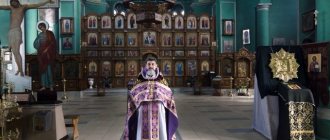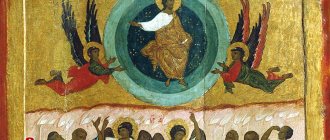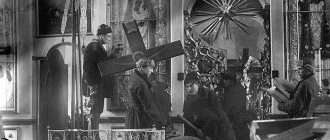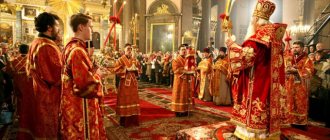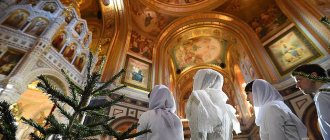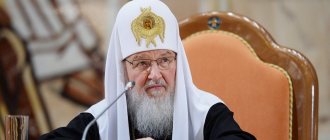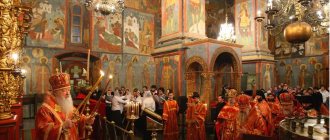To understand what the current “monasteries” are like - they are collapsing, because people are, to put it mildly, reluctant to become monks, and the number of people who are de-clothed is becoming ever greater - it is useful to turn to the opinion of the residents of the villages living in the neighborhood.
We bring to your attention a transcript of a video interview with a resident of the village. Solovki (Solovetsky Islands), August 25. 2018
1.5 million views, more than 5 thousand comments (10:00, August 30, 2022)
We draw attention to the fact that starting from 2009, the Valaam governor, Bishop Pankraty Zherdev, took an active part in the fate of the modern Solovetsky monastery, introducing his invention into this and other dying monasteries - the “Shift Monastery”. It was assumed that the monks would move from monastery to monastery “in a circle.”
Apparently, it didn’t help: according to a Solovetsky resident, only 8 (eight) monks eat in the monastery refectory - not enough! In the collective photos there are 20–30 monks and monks, without workers, of course. But local people know better!
In fact, the Solovchanian talks about typical monastic morals and customs .
“Dear meeting participants, the main problem of Solovki is the lack of an integrated approach to preserving the cultural and natural heritage of the archipelago”
From the speech of Patriarch Kirill at the Board of Trustees for the revival of the Solovetsky Monastery
How much do clergymen earn?
In big cities, the salaries of high-ranking priests can reach up to a million rubles, but in the outback you can often find ministers who do not receive money at all for their service in the church and earn their living by worldly labor.
As a rule, the salary for a church minister is a certain percentage of donations. Therefore, you can get different money from different temples.
Since the church is not a commercial organization, it must manage its own provision. The Russian Orthodox Church has a number of its own enterprises, which use their profits to support 34.5 thousand churches and 293 dioceses. At the same time, “unprofitable” churches can contact higher dioceses and ask for financial assistance.
See also:
How much do police officers in different countries earn?
In Russia
In Moscow, an ordinary priest can earn about 80 thousand rubles, in St. Petersburg - about 50 thousand, but in the outback he can live on the minimum wage, or even lower. It all depends on the parish, because in big cities and regional centers there are more people, they are wealthier, and in addition, many churches have their own wealthy patrons. In the outback there are fewer people, and their incomes, as a rule, do not allow them to make significant donations.
The abbots of the temple are considered to be a kind of superiors over the priests: they monitor the order, diligence and education of their subordinates. Moreover, their salary in large populated areas may well reach a million.
Bishops are the highest rank in the Orthodox Church. The income of such a clergyman can even amount to several million, but no one knows the exact figures.
Wealth can only be assessed by their appearance and the luxury items they have. For example, the long-standing scandal with the incredibly expensive watch of Patriarch Kirill made it clear that he is rich not only spiritually.
Abroad
There are countries in which priests are considered government employees and receive wages under general conditions. This system operates in Germany, Belgium and France. For example, a Belgian priest teaches no more than 2 thousand euros, and a bishop - about 6 thousand. The French are more modest, and their priest receives 950 euros (which is lower than the minimum wage), but at the same time he has the opportunity to enjoy free housing and all the benefits of civil servants.
In Italy, there is a special fund to pay pensions and salaries for priests, and the average income of an ordinary clergyman fluctuates around 800 euros. In the USA, the clergy can count on 1-2 thousand dollars.
Power: football with the boys. The gathering will wait
— The governor came here. Arrived. The governor arrived on four planes! He brought Valuev, Tretyak, he brought some other riffraff there, the entire government of the Arkhangelsk region. Why did you come here? At whose expense? And here they organized football battles with the boys. Grandmothers walked, our residents spat, *I…. And then they asked him [the governor]: At least hold a meeting, people want you to gather everyone, people have a lot of complaints. But he didn’t do this - he sat down and flew away! What is this, power?! Who needs such power?! All about yourself, the same Tretyak, Valuev. Valuev promised the schoolchildren: we will build a stadium over there, right behind the school, you will play bandy. They still play and remember him: he brought, somewhere, about thirty sticks, these orange “Bandy Hockey” balls, a uniform, a uniform, and where to play? On the roads? On snow?! Where to play?!
- Well, did the patriarch come to Solovki?
— The Patriarch comes every year. So what? He has one thing to do - politics. He has arrived, he is arriving, you can’t approach him. He was guarded more sharply than Putin was guarded in 2001. I drove [then] Putin’s shepherd dogs, I drove security when he came in 2001. He just arrived here on August 20, 2001.
What benefits do church ministers enjoy?
The Orthodox clergy in Russia are officially exempt from income taxes on their businesses. This right applies only to the production and sale of church paraphernalia, for example, candles.
If the parish decides that it would be appropriate to sell soft toys or food products on the church premises, the tax from such trade will still need to be given to the state.
Also, each representative of the church has the right to leave from 20 to 30 days, but for a clergyman it is special. Even on vacation, he must fulfill his main duties: pray, receive communion, and confess.
See also:
How much do deputies of different levels earn in Russia in 2022 and why shouldn’t we live like that?
Religious composition
For the reasons described above, there is simply no current Rosstat data on the religious composition of the population at the beginning of 2022. The last serious survey on this topic took place in 2012. It gave the following results.
| Orthodox | 41,00% |
| Non-religious believers | 25,00% |
| Atheists | 13,00% |
| Muslims | 4,70% |
| Christians | 4,10% |
| Sunni Muslims | 1,70% |
| Orthodox outside a specific church | 1,50% |
| Pagans | 1,20% |
| Buddhists | 0,50% |
| Old Believers | 0,50% |
| Shia Muslims | 0,50% |
| Catholics | 0,50% |
| Judaists | 0,50% |
| Hindus | 0,50% |
| Pentecostals | 0,50% |
| Others and undecided | 4,30% |
| TOTAL | 100,00% |
In a more visual chart format, the data looks like this. For ease of perception, different movements of Islam are combined into one, and religions with a share of less than 1.5% are collected in one group.
The surveys that were conducted later were not so large-scale. But their data allows us to assert that the religious composition of the Russian population has not undergone major changes over the next 9 years. In general, the situation at the turn of 2020-2021 remains approximately the same.
Do priests receive pensions?
In Soviet times, they could not claim a pension, but since 2004 the church has officially made contributions to the Pension Fund for each of its employees. The amounts, as well as salaries, directly depend on each individual church. Monks, as a rule, even when receiving a pension, give it to the needs of the monastery.
As it turns out, a church career is not much different from a secular one. Priests also hold different positions, go on vacation, and receive a fixed salary and bonuses. And they also always need to start their career with a low-paying job, gradually increasing their experience and, accordingly, their salary.
Permitted religions
The fundamental law of the country (constitution) provides for freedom of religion. There is no authorized state body to control the activities of religious organizations.
This state of affairs may change - in 2008, a corresponding amendment was made to the law on religious associations. The first precedent is the creation of a department for religious affairs in Tatarstan (based on the transformation of the specialized council under the cabinet of ministries of the republic).
Number of churches and temples in Russia
As noted above, the data of Rosstat and the Russian Orthodox Church do not coincide on this issue. The following is information from the official statistical office, which has been published annually for the past several years and is based on the number of registered religious organizations.
On years
First, it makes sense to look at the statistics by year. According to Rosstat data, it looks like this:
| Year | Number of religious organizations |
| 2010 | 12 941 |
| 2011 | 13 265 |
| 2012 | 13 943 |
| 2013 | 14 522 |
| 2014 | 15 196 |
| 2015 | 16 076 |
| 2016 | 16 687 |
| 2017 | 17 687 |
| 2018 | 18 191 |
| 2019 | 18 550 |
Even a cursory analysis shows positive dynamics of the parameter in question. Annual growth varies from 2% to 6%, but is present throughout the entire time period.
It makes sense to cite the data of the Russian Orthodox Church posted on the official website of the Moscow Patriarchate. In accordance with them, the number of churches and premises for worship was 29.3 thousand in 2009, and 38.6 thousand in 2022. Thus, the growth over 10 years was more than 31%, which is slightly lower than according to Rosstat (almost 44% for the same period). It is necessary to take into account that the statistical agency collects information exclusively for Russia, and the Russian Orthodox Church - all over the world, including Ukraine and Belarus, where the number of Orthodox churches and prayer rooms is especially large.
By region
The regional distribution of temples and churches is very uneven. This is not surprising, since in the territory of certain constituent entities of the Russian Federation, for example, national republics - Tatarstan, Bashkiria, Chechnya and others - the predominant religion is Islam. This is clearly shown in the following image.
Number of monastics in 1825–1914*
| Year | Monks | Novices | Nuns | Novices | Total |
| 1825 | 3727 | 2015 | 1882 | 3456 | 11080 |
| 1840 | 5122 | 3259 | 2287 | 4583 | 15251 |
| 1850 | 4978 | 5019 | 2303 | 6230 | 18530 |
| 1860 | 5648 | 5554 | 2931 | 7669 | 21802 |
| 1870 | 5750 | 5710 | 3226 | 11412 | 26098 |
| 1880 | 6481 | 2902 | 4759 | 14071 | 28213 |
| 1890 | 7189 | 5523 | 7306 | 20268 | 40286 |
| 1900 | 8578 | 8090 | 10082 | 31533 | 58283 |
| 1914 | 11845 | 9485 | 17283 | 56016 |
[] RIO. St. Petersburg, 1902. T. 113, book. 1; Preobrazhensky I. The Fatherland Church according to statistical data from 1840/41 to 1890/91. St. Petersburg, 1901; The most humble report of the Chief Prosecutor of the Holy Synod K. Pobedonostsev for the Department of Orthodox Confession for 1900. St. Petersburg, 1903. Appendix; The most humble report of the Chief Prosecutor of the Holy Synod for the Department of Orthodox Confession for 1914. Pg., 1916.
Dynamics of growth rates in comparison with other areas
The above data acquires especially noticeable relevance if we compare the dynamics of changes in the number of churches with other no less socially significant objects. In this case, we are talking about institutions in two key areas of life – healthcare and education. Statistics on the number of churches, kindergartens, schools and hospitals in the context of 2010-2019 are given in the table.
| Number of objects in thousands | 2010 | 2011 | 2012 | 2013 | 2014 | 2015 | 2016 | 2017 | 2018 | 2019 | Dynamics over 10 years |
| Churches of the Russian Orthodox Church | 12,9 | 13,3 | 13,9 | 14,5 | 15,2 | 16,1 | 16,7 | 17,7 | 18,2 | 18,6 | 144% |
| Kindergartens | 45,1 | 44,9 | 44,3 | 43,2 | 51 | 50,1 | 49,4 | 48,6 | 47,8 | 47,1 | 104% |
| Schools | 50,8 | 47,7 | 46,2 | 44,7 | 44,8 | 43,4 | 42,6 | 42 | 41,3 | 81% | |
| Hospitals | 6,3 | 6,2 | 6,2 | 5,9 | 5,6 | 5,4 | 5,4 | 5,3 | 5,3 | 5,2 | 83% |
Particular attention should be paid to the last column. It shows that the number of churches has increased by 44% in 10 years. Another parameter – the number of kindergartens – also has positive dynamics. But in this case, the growth was only 4%, with a decline observed in the last 5 years. The other two indicators under consideration – the number of schools and hospitals – show negative dynamics.
Moreover, the decline over 10 years was almost 20% for each parameter.
How did the number of churches decrease?
During the 20th century, the state's attitude towards religion in general and the Russian Orthodox Church in particular changed repeatedly. Orthodoxy was one of the pillars of the Russian Empire, therefore, at the end of 2016, there were 55,173 churches and more than 25 thousand chapels operating in the country.
Their numbers declined rapidly over the next few years. At the beginning of 1941, the number of Orthodox churches was 4,225.
After the start of the Great Patriotic War, the number of churches and houses of worship increased slightly again. According to some estimates, at the end of 1945 it was approximately 20 thousand.
After the end of the war, negative dynamics emerged again. By 1961, the number of churches and houses of worship of the Russian Orthodox Church was 11,572. By 1988, the number of parishes had decreased to 6,893.
The collapse of the Soviet Union again radically changed state policy towards religion. The result was a sharp increase in the number of parishes. At the end of 1994, their number was 15,985, in 2004 - 26,590, in 2011 - 30,675, at the beginning of 2022 - 38,649 churches and other places of worship.
It is necessary to understand that all the above figures apply not only to Russia, but to all territories where the Russian Orthodox Church operates. This approach allows for correct comparisons of the dynamics of the number of churches. Moreover, the borders of Russia and the Soviet Union have changed several times, and therefore statistics for one state will simply be greatly distorted. Below is a graph of changes in the number of churches and houses of worship of the Russian Orthodox Church.
It is important to note that even today the number of Russian Orthodox Church churches is inferior to pre-revolutionary figures. Even if the current positive dynamics are maintained, it will probably not be possible to reach the levels of 1916 in the next few years.

